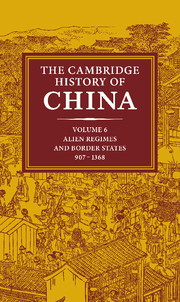Book contents
- Frontmatter
- Introduction
- 1 The Liao
- 2 The Hsi Hsia
- 3 The Chin dynasty
- 4 The rise of the Mongolian empire and Mongolian rule in north China
- 5 The reign of Khubilai khan
- 6 Mid-Yüan politics
- 7 Shun-ti and the end of Yüan rule in China
- 8 The Yüan government and society
- 9 Chinese society under Mongol rule, 1215–1368
- Bibliographical essays
- Bibliography
- Glossary-Index
- MAP 7. The Liao empire, ca. 1045
- MAP 12. The Hsi Hsia state, IIII
- Map 17. The Chin empire
- MAP 32. The Yüan empire">
- References
3 - The Chin dynasty
Published online by Cambridge University Press: 28 March 2008
- Frontmatter
- Introduction
- 1 The Liao
- 2 The Hsi Hsia
- 3 The Chin dynasty
- 4 The rise of the Mongolian empire and Mongolian rule in north China
- 5 The reign of Khubilai khan
- 6 Mid-Yüan politics
- 7 Shun-ti and the end of Yüan rule in China
- 8 The Yüan government and society
- 9 Chinese society under Mongol rule, 1215–1368
- Bibliographical essays
- Bibliography
- Glossary-Index
- MAP 7. The Liao empire, ca. 1045
- MAP 12. The Hsi Hsia state, IIII
- Map 17. The Chin empire
- MAP 32. The Yüan empire">
- References
Summary
GENERAL REMARKS
It has long been recognized that the dynastic pattern is not a very satisfactory criterion for periodizing Chinese history. A certain exception must, however, be made for dynasties of conquest in which the rule of an imperial house is at the same time a period of foreign domination. One of these is the Chin dynasty (1115–1234), which first overthrew the Khitan state of Liao and continued alien rule over large parts of northern China, although under a different ruling group, the Jurchen people. It is too easily forgotten that the region of modern Peking was continuously under non-Chinese rule – with all the resulting social and anthropological influences – for more than four hundred years. First the Khitans invaded the north of China, then the Jurchens came, and finally, from the early thirteenth century onward the Mongols, who, in contrast with Khitans and Jurchens, were successful in subjugating the whole of China. The rule of the Chin dynasty and the Jurchens is therefore a link in the chain of non-Chinese invasions from the northern border regions into China proper; at the same time, however, the Chin state had many distinctive features. Not the least important of these were the methods by which the Jurchens dominated the Chinese. The Khitans, the Jurchens, and the Mongols in turn each practiced a different way of government and accepted Chinese civilization to varying degrees. A comparison of these features may therefore lead to a comparative typology of alien rule over China.
- Type
- Chapter
- Information
- The Cambridge History of China , pp. 215 - 320Publisher: Cambridge University PressPrint publication year: 1994
References
- 4
- Cited by



